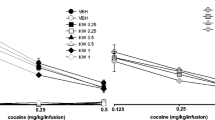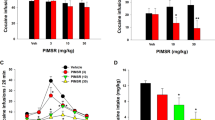Abstract
Rationale
L-type Ca2+ channels (LTCC) and GABAB receptors are both possible targets in the development of new pharmacological compounds for cocaine addiction. Drugs that target either receptor attenuate a wide range of cocaine-seeking behaviors in the rat. However, there is no current human-approved pharmacotherapeutic intervention for psychostimulant addiction.
Objectives
This study examined the effects of a human-approved LTCC blocker, fendiline, on cocaine-taking and cocaine-seeking behavior in rats. The effects of combining fendiline with the GABAB receptor agonist baclofen on cocaine self-administration were also tested.
Methods
Male Wistar rats were trained to self-administer cocaine, and the effects of fendiline pretreatment (vehicle, 1.78, 3.16, 5.62 mg/kg, intraperitoneal (IP)) were tested on progressive ratio responding and cue- and drug-induced reinstatement. The effects of baclofen (vehicle, 0.56, 1.78, 3.16, 5.62 mg/kg, IP) combined with fendiline (5.62 mg/kg, IP) were tested on progressive ratio responding. Control experiments measured locomotor activity and lever pressing for food in rats that received both baclofen and fendiline prior to the test session.
Results
Acute injections of fendiline prior to cue- or drug-induced reinstatement significantly attenuated lever-pressing behavior (p < 0.05). Fendiline and baclofen, but not fendiline alone, not only significantly attenuated breakpoints, but also impaired general motor behavior and naturalistic reinforcement (p < 0.05).
Conclusion
These data suggest that the LTCC blocker fendiline may represent a novel pharmacotherapeutic intervention to prevent reinstatement to cocaine seeking. Also, co-administration of fendiline and baclofen not only can attenuate the motivation to take cocaine, but also impairs general motor behavior and naturalistic reinforcement.






Similar content being viewed by others
References
Arnold JM, Roberts D (1997) A critique of fixed and progressive ratio schedules used to examine the neural substrates of drug reinforcement. Pharmacol Biochem Be 57:441–447
Bailey CP, Husbands SM (2014) Novel approaches for the treatment of psychostimulant and opioid abuse-focus on opioid receptor-based therapies. Expert Opin Drug Dis 9:1333–1344
Bayer R, Mannhold R (1986) Fendiline: a review of its basic pharmacological and clinical properties. Pharmatherapeutica 5:103–136
Berger SM, Bartsch D (2014) The role of L-type voltage-gated calcium channels Cav1.2 and Cav1.3 in normal and pathological brain function. Cell Tissue Res 357:463–476
Berger SP, Reid MS, Delucchi K et al (1996) Haloperidol antagonism of cue-elicited cocaine craving. Lancet 347:504–508
Biala G (2002) Calcium channel antagonists suppress nicotine-induced place preference and locomotor sensitization in rodents. Pol J Pharmacol 55:327–335
Biala G, Budzynska B (2008) Calcium-dependent mechanisms of the reinstatement of nicotine-conditioned place preference by drug priming in rats. Pharmacol Biochem Be 89:116–125
Brebner K, Phelan R, Roberts DC (2000a) Effect of baclofen on cocaine self-administration in rats reinforced under fixed-ratio 1 and progressive-ratio schedules. Psychopharmacology 148:314–321
Brebner K, Phelan R, Roberts DC (2000b) Intra-VTA baclofen attenuates cocaine self-administration on a progressive ratio schedule of reinforcement. Pharmacol Biochem Be 66:857–862
Brebner K, Childress AR, Roberts DC (2002) A potential role for GABAB agonists in the treatment of psychostimulant addiction. Alcohol Alcoholism 37:478–484
Brebner K, Ahn S, Phillips AG (2005) Attenuation of d-amphetamine self-administration by baclofen in the rat: behavioral and neurochemical correlates. Psychopharmacology 177:409–417
Campbell U, Lac S, Carroll M (1999) Effects of baclofen on maintenance and reinstatement of intravenous cocaine self-administration in rats. Psychopharmacology 143:209–214
Chen Y, Phillips K, Minton G, Sher E (2005) GABAB receptor modulators potentiate baclofen-induced depression of dopamine neuron activity in the rat ventral tegmental area. Brit J Pharmacol 144:926–932
Cryan JF, Kelly PH, Chaperon F et al (2004) Behavioral characterization of the novel GABAB receptor-positive modulator GS39783 (N, N′-dicyclopentyl-2-methylsulfanyl-5-nitro-pyrimidine-4, 6-diamine): anxiolytic-like activity without side effects associated with baclofen or benzodiazepines. J Pharmacol Exp Ther 310:952–963
Filip M, Frankowska M (2007) Effects of GABAB receptor agents on cocaine priming, discrete contextual cue and food induced relapses. Eur J Pharmacol 571:166–173
Filip M, Frankowska M, Przegaliński E (2007) Effects of GABAB receptor antagonist, agonists and allosteric positive modulator on the cocaine-induced self-administration and drug discrimination. Eur J Pharmacol 574:148–157
Ford KA, Wolf ME, Hu XT (2009) Plasticity of L-type Ca2+ channels after cocaine withdrawal. Synapse 63:690–697
Haney M, Collins ED, Ward AS, Foltin RW, Fischman MW (1999) Effect of a selective dopamine D1 agonist (ABT-431) on smoked cocaine self-administration in humans. Psychopharmacology 143:102–110
Kerr DI, Ong J, Puspawati NM, Prager RH (2002) Arylalkylamines are a novel class of positive allosteric modulators at GABAB receptors in rat neocortex. Eur J Pharmacol 451:69–77
Koob GF, Volkow ND (2010) Neurocircuitry of addiction. Neuropsychopharmacol 35:217–238
Kuzmin A, Semenova S, Ramsey N, Zvartau E, Ree J (1996) Modulation of cocaine intravenous self-administration in drug-naive animals by dihydropyridine Ca2+ channel modulators. Eur J Pharmacol 295:19–25
Licata SC, Pierce RC (2003) The roles of calcium/calmodulin-dependent and Ras/mitogen-activated protein kinases in the development of psychostimulant-induced behavioral sensitization. J Neurochem 85:14–22
Licata SC, Freeman AY, Pierce-Bancroft AF, Pierce RC (2000) Repeated stimulation of L-type calcium channels in the rat ventral tegmental area mimics the initiation of behavioral sensitization to cocaine. Psychopharmacology 152:110–118
Licata SC, Schmidt HD, Pierce RC (2004) Suppressing calcium/calmodulin-dependent protein kinase II activity in the ventral tegmental area enhances the acute behavioural response to cocaine but attenuates the initiation of cocaine-induced behavioural sensitization in rats. Eur J Neurosci 19:405–414
Liu Y, Harding M, Pittman A et al (2014) Cav1. 2 and Cav1. 3 L-type calcium channels regulate dopaminergic firing activity in the mouse ventral tegmental area. J Neurophysiolo 112:1119–1130
Lynch WJ, Nicholson KL, Dance ME, Morgan RW, Foley PL (2010) Animal models of substance abuse and addiction: implications for science, animal welfare, and society. Comparative Med 60:177–188
McGregor A, Baker G, Roberts DCS (1996) Effect of 6-hydroxydopamine lesions of the medial prefrontal cortex on intravenous cocaine self-administration under a progressive ratio schedule of reinforcement. Pharmacol Biochem Be 53:5–9
Rajadhyaksha AM, Husson I, Satpute SS et al (2004) L-type Ca2+ channels mediate adaptation of extracellular signal-regulated kinase ½ phosphorylation in the ventral tegmental area after chronic amphetamine treatment. J Neurosci 24:7464–7476
Ranaldi R, Poeggel K (2002) Baclofen decreases methamphetamine self-administration in rats. Neuroreport 13:1107–1110
Richardson NR, Roberts DCS (1996) Progressive ratio schedules in drug self-administration studies in rats: a method to evaluate reinforcing efficacy. J Neurosci Meth 66:1–11
Roberts DCS, Goeders N (1989) Drug self-administration: experimental methods and determinants. In: Boulton AA, Baker GB, Greenshaw AJ (eds) Neuromethods: psychopharmacology. Humana Press Inc., Clifton NJ, pp 439–398
Roberts DCS, Andrews MM, Vickers GJ (1996) Baclofen attenuates the reinforcing effects of cocaine in rats. Neuropsychopharmacol 15:417–424
Shoptaw S, Yang X, Rotheram-Fuller EJ et al (2003) Randomized placebo-controlled trial of baclofen for cocaine dependence: preliminary effects for individuals with chronic patterns of cocaine use. J Clin Psychiat 64:1440–1448
Suzuki T, Shiozaki Y, Masukawa Y, Misawa M (1992) Effects of calcium antagonists on the cocaine-and methamphetamine-induced conditioned place preference. Arukoru Kenkyuto Yakubutsu Ison 27:81–90
Urwyler S, Gjoni T, Kaupmann K, Pozza MF, Mosbacher J (2004) Selected amino acids, dipeptides and arylalkylamine derivatives do not act as allosteric modulators at GABAB receptors. Eur J Pharmacol 483:147–153
Voigt RM, Riddle JL, Napier TC (2014) Effect of fendiline on the maintenance and expression of methamphetamine-induced conditioned place preference in Sprague–Dawley rats. Psychopharmacology 231:2019–2029
Wise RA (1996) Neurobiology of addiction. Curr Opin Neurobiol 6:243–251
Zhang L, Liu Y, Chen X (2005) Carbachol induces burst firing of dopamine cells in the ventral tegmental area by promoting calcium entry through L type channels in the rat. J Physiol Lond 568:469–481
Acknowledgments
The authors would like to thank Anthony Phillips for his comments and suggestions in the preparation of this article. This research was supported by CFI/NSRIT #17561, NSHRF MED-Project-2008-4695, and St FX UCR #91642.
Conflict of interest
There are no conflicts of interest to report.
Author information
Authors and Affiliations
Corresponding author
Rights and permissions
About this article
Cite this article
Cunningham, J.J., Orr, E., Lothian, B.C. et al. Effects of fendiline on cocaine-seeking behavior in the rat. Psychopharmacology 232, 4401–4410 (2015). https://doi.org/10.1007/s00213-015-4061-4
Received:
Accepted:
Published:
Issue Date:
DOI: https://doi.org/10.1007/s00213-015-4061-4




